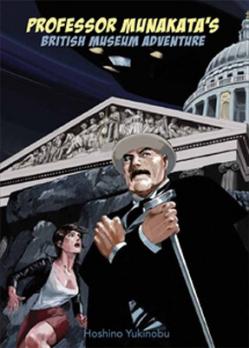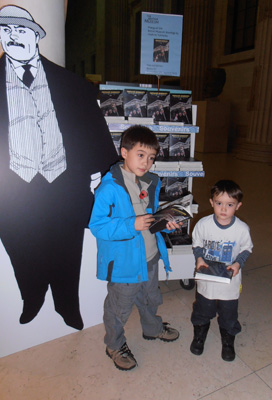Professor Munakata’s British Museum Adventure by Yukinobu Hoshino translated by Nicole Coolidge Rous

Review by: Sean Curtin
This beautifully illustrated work by the renowned Japanese artist Yukinobu Hoshino (星野 之宣) manages to perfectly capture the unique atmosphere of the British Museum. Hoshino’s meticulous artwork successfully transports the world famous institute, plus several of its curators, into the alternate reality of the manga world. Hoshino places Professor Munakata (宗像教授), his best known character, into an extraordinary web of intrigue centred round the museum and its eclectic collection of amazing artefacts. The internal and external depictions of the iconic museum from a host of angles and perspectives are masterfully drawn in superb detail. Anyone who appreciates the building’s elegant architecture will enjoy Hoshino’s exquisite artwork, even if they are not particularly interested in the manga genre.
The enthralling narrative begins with the distinguished Professor invited to the British Museum to give a lecture on mythology and folklore. However, at about the same time the majestic Stonehenge megaliths on Salisbury Plain are somehow stolen. The Professor’s investigations lead him into a sinister and tangled plot that threatens the museum itself along with some of its most important collections and prize exhibits. Much of the action takes place in various galleries and locations within the museum with each presented in fantastic detail. My only real complaint is that at one point in the action the roof of the magnificent Great Court is severely damaged and even though this is only in the fictional manga world, the sight of such destruction is quite disturbing.
The extraordinary tale was originally published over five months during 2010 in ten instalments in the popular Japanese magazine Big Comic [ビッグコミック]. The British Museum Press has compiled and translated these ten episodes into one slick English language volume. To give the work an authentic manga feel reading is from right to left with the trademark manga sound captions retained in the original Japanese. The book also contains several supplementary features including an interview with Hoshino, an essay on the history of manga entitled “From Ukiyo-e to Manga” by Timothy Clark, plus useful reference material. Some of the black and white strip is in gorgeous colour further enhancing the work and making this a highly attractive publication.
The book was launched at Daiwa House in London on 8 November 2011 by Dr Rayna Denison and Dr Nicole Coolidge Rousmaniere, whose manga alter ego appears in the story. Dr Denison presented a fascinating and energetic overview on the history of manga while Dr Rousmaniere gave some insights and background into the story itself. She traced the genesis of the project back to 2009 when Hoshino attended a small exhibition of his work at the British Museum. The artist was deeply impressed by the marvellous interiors of the museum and its incredible collections while the curators were eager for him to take the museum into the manga realm.

Dr Rousmaniere, who currently also serves as a project curator in the museum’s Department of Asia, worked closely with Hoshino during the creation of Professor Munakata’s British Museum Adventure. She is the inspiration for the key character of Chris Caryatid who accompanies the Professor in the tale. Dr Rousmaniere also detailed how Hoshino integrated experiences from his time in the museum and well known London locations into the narrative.
The character of Professor Tadakusu Munakata (宗像 伝奇) was first conceived by Hoshino in 1990 and has subsequently become one of Japan’s most famous manga characters. Millions of readers eagerly await his adventures which appear fortnightly in the magazine Big Comic. Because the strip appears every two weeks, Hoshino has to work to a gruelling schedule to meet the deadlines. This meant the time he could spend in London was limited. In many respects the British Museum is a perfect backdrop for the Professor who is a historical ethnographer dedicated to unravelling mysteries. In previous adventures the intrepid academic has discovered ancient burial grounds and participated in deadly Agatha Christie style archaeological excavations.
The museum is currently exhibiting an exclusive display of some of Hoshino’s original artwork from the book accompanied by explanations of how he created illustrations in the story. This is scheduled to run until 8 April 2012 and is worth seeing, especially if you or your children have purchased the book.

While this publication is primarily aimed at manga aficionados and young adults, its appeal is much wider and it makes a highly attractive museum souvenir. Children familiar with the British Museum will also greatly enjoy it. My nine-year-old son thought it was brilliant as did several of his friends. They especially liked the fact that places they know in the museum along with famous objects like the Rosetta Stone are featured. This is something that will no doubt also appeal to British Museum Young Friends. The only gripe I heard from the children was the price, £14.99, which was beyond the normal pocket money allowance. The museum produced this volume so it would include the entire original ten episodes, but I hope there may be a possibility in the future for individual episodes to be published. If this were the case, smaller booklet formats should be within the pocket money range of young children. One thing seems certain, Hoshino’s magnificent manga incarnation of the British Museum is destined for a long life and represents an excellent export of this Japanese art form.

